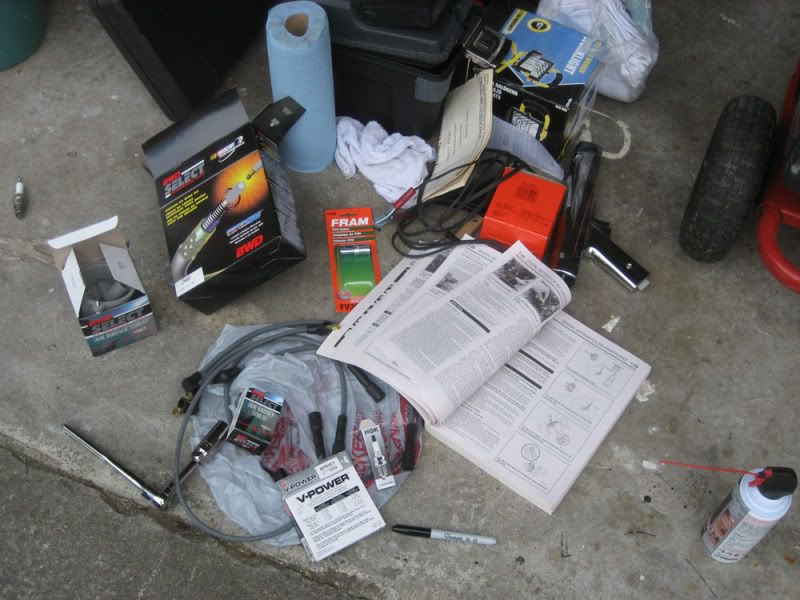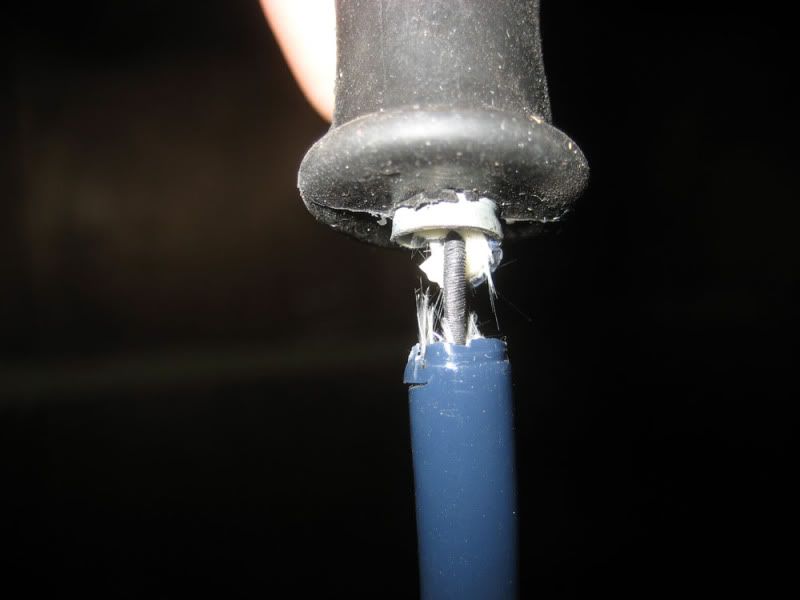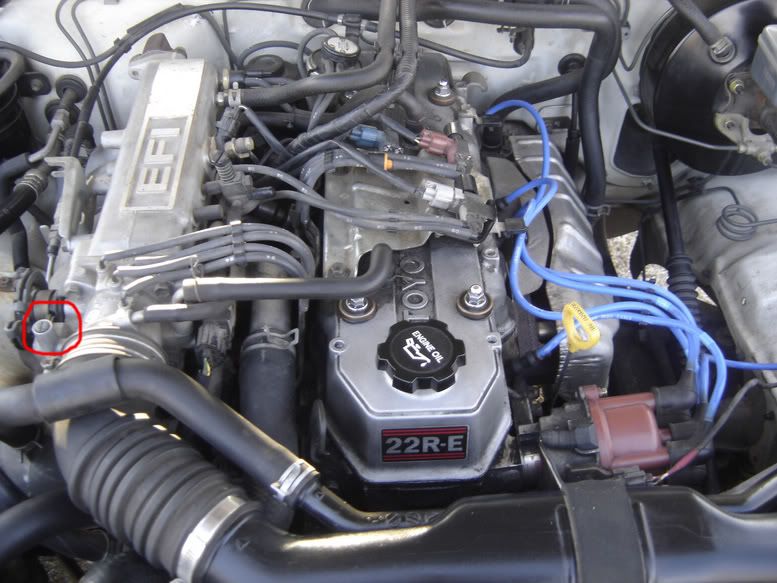'90 22R-E Fails HC Idle Emissions Test
#1
'90 22R-E Fails HC Idle Emissions Test
Hello, I'm trying to learn more about my truck so please forgive my ignorance, but I'm hoping you can help me. I took my recently purchased 1990 4x4 Truck (22R-E) to get the emissions checked so I could get my tabs for another year. Here in WA, you need to spend $150 to waive your emissions test if it won't pass. So, I had my rig checked out by a service center to meet that requirement and they noted the following:
"Check timing. Base timing good 5 BTDC. Inspect ignition component. Cap rotor wires and plugs all look good and have been replaced recently. Look for vacuum leaks. None found. Do Cat test. Cat in good shape. Suspect leaking fuel injectors."
My question is: Do you agree that the fuel injectors are the likely culprit, and would you recommend I replace them or look for another cause?
The truck runs fine otherwise, though it does seem to idle a bit slower than I would like (approx. 500RPM). It has a rebuilt 22R-E with under 70k miles.
More detailed results about the emissions test:
HC (PPM)
Cruise Limit: 160
Cruise Emissions: 62
Cruise Result: PASS
Idle Limit: 220
Idle Emissions: 712
Idle Result: FAIL
CO (%)
Cruise Limit: 1.2
Cruise Emissions: 0.11
Cruise Result: PASS
Idle Limit: 1.2
Idle Emissions: 0.24
Idle Result: PASS
Thank you much for any assistance you can provide.
"Check timing. Base timing good 5 BTDC. Inspect ignition component. Cap rotor wires and plugs all look good and have been replaced recently. Look for vacuum leaks. None found. Do Cat test. Cat in good shape. Suspect leaking fuel injectors."
My question is: Do you agree that the fuel injectors are the likely culprit, and would you recommend I replace them or look for another cause?
The truck runs fine otherwise, though it does seem to idle a bit slower than I would like (approx. 500RPM). It has a rebuilt 22R-E with under 70k miles.
More detailed results about the emissions test:
HC (PPM)
Cruise Limit: 160
Cruise Emissions: 62
Cruise Result: PASS
Idle Limit: 220
Idle Emissions: 712
Idle Result: FAIL
CO (%)
Cruise Limit: 1.2
Cruise Emissions: 0.11
Cruise Result: PASS
Idle Limit: 1.2
Idle Emissions: 0.24
Idle Result: PASS
Thank you much for any assistance you can provide.
#2
Hydrocarbons are just unburned fuel molecules, meaning more gasoline than normal is remaining unburned in your engine.
That you passed at cruising speed and failed at idle, and your idle is low suggests to me that it is possible that turning up your idle to 750rpm (Toyota spec) might fix the problem. There's a slotted screw on top of the top right of the throttle body, right where the plastic intake duct come in. Turn it and check the tach.
I doubt its a mechanical problem as it passed at cruise just fine, but the low idle speed is probably causing the ECU confusion.
You can clean you injectors out with "injector cleaner" available at any parts store.
That you passed at cruising speed and failed at idle, and your idle is low suggests to me that it is possible that turning up your idle to 750rpm (Toyota spec) might fix the problem. There's a slotted screw on top of the top right of the throttle body, right where the plastic intake duct come in. Turn it and check the tach.
I doubt its a mechanical problem as it passed at cruise just fine, but the low idle speed is probably causing the ECU confusion.
You can clean you injectors out with "injector cleaner" available at any parts store.
Last edited by Matt16; 10-02-2008 at 01:28 AM.
#3
Thanks Matt for your response. That helps me understand a bit more. Today I changed the oil and bought some injector cleaner from the store. Then I filled up the tank and used the injector cleaner. It seems to run slightly more smooth, but I have a question about the idle screw. I couldn't seem to find it, and in my Chiltons manual it mentioned that it was controlled by a computer and that I couldn't adjust the idle speed. No mention of a idle screw. What are your thoughts? Could you perhaps post a picture of where this screw is located on a 22R-E?
Thank you!
Thank you!
#5
Thank you for the picture, I couldn't find a single picture of the idle screw location on a 22R-E on the internets through Google, or from my manual, so I appreciate it. I look forward to giving this a try tonight, and I'll let you know how it goes.
#7
Alright, I adjusted the idle screw and that fixed the chugging idle problem, now I'm hovering around a far less shaky 800RPMs or so. I also have used about half my tank of gas with the fuel injector cleaner in it.
Feeling confident, I went and took my free emissions re-test. I failed it again, but I got about 100 points better on my HC Idle.
What's next? Should I look to the fuel injectors as the cause?
Thanks again.
Feeling confident, I went and took my free emissions re-test. I failed it again, but I got about 100 points better on my HC Idle.
What's next? Should I look to the fuel injectors as the cause?
Thanks again.
Trending Topics
#9
It can't hurt to pull the injectors. There are several places that will clean, test, and balance you injectors for 20~30 each. When I bought my truck I one messed up injector and an injector that didn't match the other three. I think I got an entire remain set for $185.
I've sent several set of injectors out for cleaning. Really the stuff you put in your tank is about worthless. It works best if you don't put it in a full tank so its less diluted. Mixing the additives and cheap gas only gives you are more expensive version of the expensive gas.
I've sent several set of injectors out for cleaning. Really the stuff you put in your tank is about worthless. It works best if you don't put it in a full tank so its less diluted. Mixing the additives and cheap gas only gives you are more expensive version of the expensive gas.
#11
I've heard BK44 injector cleaner works well BUT, I think that with the technology in cleaning additives mixed in to your gasoline, and the fact that 22REs were designed to be robust makes me think that your injectors are likely alright. That is purely speculative though.
Are you warming the truck up before the test? When the engine starts cold, there is no way even a modern engine in perfect running order would pass a emissions test if not warmed up properly. That's the most parsimonious possible solution I can think of.
Are you warming the truck up before the test? When the engine starts cold, there is no way even a modern engine in perfect running order would pass a emissions test if not warmed up properly. That's the most parsimonious possible solution I can think of.
Last edited by Matt16; 10-05-2008 at 12:13 AM.
#12
imho: Toyota injectors are pretty bulletproof. They rarely go bad.
#13
that's where I was going with the question, anotherjeff. 
...I was just waiting for an answer.
a maladjusted TPS could cause the problem too, without being fault,
if the throttle itself is incorrectly adjusted, that affects the TPS also.

...I was just waiting for an answer.
a maladjusted TPS could cause the problem too, without being fault,
if the throttle itself is incorrectly adjusted, that affects the TPS also.
Last edited by abecedarian; 10-05-2008 at 09:38 AM.
#14
Thanks guys for your responses, I'm grateful.
No, I did not, I am ignorant about how to adjust timing. I will check that out in my manual, or if you have something I could read for reference, that would be good.
Yes, I had driven the truck for half an hour before taking the test, on the freeway and in stop-and-go traffic.
I'm guessing that TPS stands for throttle position sensor? I don't know how to adjust that, but I will read up. I immediately thought: I will refer to my manual for figuring out timing/TPS issues, but if you have any suggestions I welcome them! I bought this truck with the intention of learning more about how to work on cars/trucks, so I hope the bulletproof and venerable 22RE is a good test subject.
I will refer to my manual for figuring out timing/TPS issues, but if you have any suggestions I welcome them! I bought this truck with the intention of learning more about how to work on cars/trucks, so I hope the bulletproof and venerable 22RE is a good test subject. 
out of curiosity, after bringing the idle speed back up, did you adjust the timing back down to spec?
Are you warming the truck up before the test?
A faulty TPS could cause the high idle HC.
a maladjusted TPS could cause the problem too, without being fault,
if the throttle itself is incorrectly adjusted, that affects the TPS also.
if the throttle itself is incorrectly adjusted, that affects the TPS also.


#15
Adjusting the timing requires connecting two terminals in the diagnostic test plug before trying to adjust the timing. I seem to recall they are labeled TE1 and E1 on your truck. A paperclip will suffice to connect them, in absence of a factory authorized diagnostic tool.
So, you'll make your 'jumper', start the truck, then insert the jumper into the appropriate terminals. When you insert the jumper, the idle should noticibly change (since the ECU is defaulting to a pre-programmed ignition advance setting). If it doesn't, your throttle position sensor is either misadjusted or malfunctioning and you'll have to correct that problem first.
Here's how to check the TPS: http://4crawler.com/4x4/CheapTricks/TPS/index.shtml
So now, inserting the jumper causes the idle to change.
Here's where you grab your timing light, 12mm wrench, and adjust the timing.
...but wait!!! when you adjust the timing the idle speed changes....
Don't fret... that's normal: timing and idle speed play a delicate dance with every engine....
So you adjust the idle, then adjust the timing, then the idle, then the timing... etc... until the idle speed and timing are correct for your truck.
So, you'll make your 'jumper', start the truck, then insert the jumper into the appropriate terminals. When you insert the jumper, the idle should noticibly change (since the ECU is defaulting to a pre-programmed ignition advance setting). If it doesn't, your throttle position sensor is either misadjusted or malfunctioning and you'll have to correct that problem first.
Here's how to check the TPS: http://4crawler.com/4x4/CheapTricks/TPS/index.shtml
So now, inserting the jumper causes the idle to change.
Here's where you grab your timing light, 12mm wrench, and adjust the timing.
...but wait!!! when you adjust the timing the idle speed changes....
Don't fret... that's normal: timing and idle speed play a delicate dance with every engine....
So you adjust the idle, then adjust the timing, then the idle, then the timing... etc... until the idle speed and timing are correct for your truck.
Last edited by abecedarian; 10-05-2008 at 04:14 PM.
#16
Hey Abecedarian, thanks for your response, I haven't forgotten I just didn't want to respond until I had actually done something substantial. I need your help for something else too now I think, see below...
Today I played mechanic and spent more than a few hours messing with my truck. The goal for the day was to pull the spark plugs and check them in addition to the wires and cap, and to check out the TPS per your recommendation. I also serviced my KM air filter with some cleaner and new oil, adjusted the timing, wiped off the engine, and inspected the throttle body intake to see if it was dirty. I also did a little bit of body work hammering out my dented box wheel well.
Since this is my first time doing much of anything on this truck, I took it very slowly and carefully. I pulled all the spark plugs and inspected them, but found that they look really new, as well as the wires and the cap. I don't think any of these components need to be replaced, because they were replaced only about 10k miles ago.
I got a timing gun and did what you said for the TE1 and E1 (and like the manual says), making a jumper with a paperclip. Took a while to figure out exactly how to adjust the distributor to bring timing into spec (5* BTDC), but I got it working and made the proper adjustments. It was running at approx 0* BTDC before I adjusted the distributor.
So, after all of this, I felt accomplished and tried driving around the truck a little bit. I noticed immediately that when I started it up, it started to sputter once every five seconds or so, making random low frequency semi-popping sounds, like what I think you would call backfire. I almost thought it was bass from the speakers in my car until I turned that off. And I noticed that while idling it was making more of a pop sound than normal in the exhaust. Everything sounds great in the engine compartment, but when I get in the truck and start driving around, in accordance with the amount of pressure I put on the gas pedal, I hear a sputtering sound from somewhere around the exhaust that rises and falls exactly with the RPMs. The sputtering is in sync with the RPMs on the tach, but is only audible when I press on the accelerator.
So to restate, when driving I only hear the sputtering sound when I press on the gas pedal, and it goes perfectly in sequence with the RPMs. It's not a random misfire or something like that, it's very constant, almost normal, except it doesn't sound normal. Inside the cab it sounds like when kids in the old days used to attach playing cards to their bikes and they would hit the spokes, kind of a flapping or light popping sound. Perhaps I could record it.
So, what do you think could have happened? Did I actually bring the timing out of spec? I cleaned the engine before I started doing work, and I sort of fear that I may have gotten a tiny bit of water in the spark plug holes when I removed them. Would a small bit of water make that kind of sputtering sound? I figured it would have evaporated and exited out the back of the truck. I also didn't remove the two distributor vacuum lines, I just clamped them off, so maybe they weren't fully clamped and my adjustments actually brought the engine out of spec? I don't know.
Your thoughts? I'm thinking of just doing a full tune up tomorrow anyway, even though the plugs/cap/wires were replaced by the previous owner, just to be safe.
Thanks again!
Today I played mechanic and spent more than a few hours messing with my truck. The goal for the day was to pull the spark plugs and check them in addition to the wires and cap, and to check out the TPS per your recommendation. I also serviced my KM air filter with some cleaner and new oil, adjusted the timing, wiped off the engine, and inspected the throttle body intake to see if it was dirty. I also did a little bit of body work hammering out my dented box wheel well.
Since this is my first time doing much of anything on this truck, I took it very slowly and carefully. I pulled all the spark plugs and inspected them, but found that they look really new, as well as the wires and the cap. I don't think any of these components need to be replaced, because they were replaced only about 10k miles ago.
I got a timing gun and did what you said for the TE1 and E1 (and like the manual says), making a jumper with a paperclip. Took a while to figure out exactly how to adjust the distributor to bring timing into spec (5* BTDC), but I got it working and made the proper adjustments. It was running at approx 0* BTDC before I adjusted the distributor.
So, after all of this, I felt accomplished and tried driving around the truck a little bit. I noticed immediately that when I started it up, it started to sputter once every five seconds or so, making random low frequency semi-popping sounds, like what I think you would call backfire. I almost thought it was bass from the speakers in my car until I turned that off. And I noticed that while idling it was making more of a pop sound than normal in the exhaust. Everything sounds great in the engine compartment, but when I get in the truck and start driving around, in accordance with the amount of pressure I put on the gas pedal, I hear a sputtering sound from somewhere around the exhaust that rises and falls exactly with the RPMs. The sputtering is in sync with the RPMs on the tach, but is only audible when I press on the accelerator.
So to restate, when driving I only hear the sputtering sound when I press on the gas pedal, and it goes perfectly in sequence with the RPMs. It's not a random misfire or something like that, it's very constant, almost normal, except it doesn't sound normal. Inside the cab it sounds like when kids in the old days used to attach playing cards to their bikes and they would hit the spokes, kind of a flapping or light popping sound. Perhaps I could record it.
So, what do you think could have happened? Did I actually bring the timing out of spec? I cleaned the engine before I started doing work, and I sort of fear that I may have gotten a tiny bit of water in the spark plug holes when I removed them. Would a small bit of water make that kind of sputtering sound? I figured it would have evaporated and exited out the back of the truck. I also didn't remove the two distributor vacuum lines, I just clamped them off, so maybe they weren't fully clamped and my adjustments actually brought the engine out of spec? I don't know.
Your thoughts? I'm thinking of just doing a full tune up tomorrow anyway, even though the plugs/cap/wires were replaced by the previous owner, just to be safe.
Thanks again!
Last edited by Monochrome; 10-10-2008 at 11:52 PM.
#17
Well, no replies but that's good because I figured out the issue. I decided to do a complete tune up in response to the engine running roughly. I changed the plugs, gapped them, changed the wires, rotor, cap, timed the engine, PCV valve, oil change, and coolant. Was about to do the fuel filter but ran out of daylight and I didn't want to work with a lamp.

I fired her up and everything sounded great! I was quite happy. It only cost about $70 for all the materials too, with about an hour and a half of work, so I was quite pleased. As I inspected the spark plug wires on #1, I saw what the problem probably was:

This did NOT happen (at least I'm 99% sure) when I pulled the plugs out or removed the wires. I was extremely careful and saw this upon inspecting the wires and carefully removing the boot.
Either way, I have a lesson learned and I should have fully inspected the cables before assuming I didn't need a tune up. Also, the distributor cap's plates were wet and there was corrosion.
So thanks for your help, my next step is to check the TPS. I don't know if I'll pass emissions after the tune up but I will check it out tomorrow to double check.
Thanks guys!

I fired her up and everything sounded great! I was quite happy. It only cost about $70 for all the materials too, with about an hour and a half of work, so I was quite pleased. As I inspected the spark plug wires on #1, I saw what the problem probably was:

This did NOT happen (at least I'm 99% sure) when I pulled the plugs out or removed the wires. I was extremely careful and saw this upon inspecting the wires and carefully removing the boot.
Either way, I have a lesson learned and I should have fully inspected the cables before assuming I didn't need a tune up. Also, the distributor cap's plates were wet and there was corrosion.
So thanks for your help, my next step is to check the TPS. I don't know if I'll pass emissions after the tune up but I will check it out tomorrow to double check.
Thanks guys!
#18
Today I fully checked the TPS by using the guide posted here: http://4crawler.com/4x4/CheapTricks/TPS/index.shtml
I tested resistance and found that my TPS is operating with the specified parameters in the chart on that site. My next thought is to remove it entirely and inspect it, but I'm inclined to think perhaps it is operating fine.
What other things can I check? I noticed yesterday that I am getting pretty poor gas mileage -- I only averaged about 16 miles to the gallon on the last tank. That was before the complete tuneup, however. and my timing was off. I haven't tested my emissions since I did the tune up, but I would like to investigate other things before I take the test.
Does anyone have other suggestions? Thank you!
I tested resistance and found that my TPS is operating with the specified parameters in the chart on that site. My next thought is to remove it entirely and inspect it, but I'm inclined to think perhaps it is operating fine.
What other things can I check? I noticed yesterday that I am getting pretty poor gas mileage -- I only averaged about 16 miles to the gallon on the last tank. That was before the complete tuneup, however. and my timing was off. I haven't tested my emissions since I did the tune up, but I would like to investigate other things before I take the test.
Does anyone have other suggestions? Thank you!
#19
I PASSED! 
Took the truck in today after the tune up and everything, and I passed with flying colors. HC Cruise was 46 with a limit of 160, and HC Idle was 156 with a limit of 220. Everything else was far below the limit.
Thanks guys for your help! I am now more confident in working on my truck.

Took the truck in today after the tune up and everything, and I passed with flying colors. HC Cruise was 46 with a limit of 160, and HC Idle was 156 with a limit of 220. Everything else was far below the limit.
Thanks guys for your help! I am now more confident in working on my truck.











